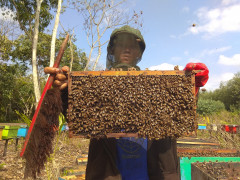Areca Palms Wilting in Terap River
By Pantau GambutFrom Minnesota to Indonesia
A land scientist from the United States Forest Service’s Research and Development Office, Randy Kolka, handed a small blackish-brown lump to a journalist named Jeremy Hance. That lump, he said, was an 8,000-year-old chunk of peat pulled from two meters underground. Hance envisioned the peat lump as a historic plant that emerged before the Egyptians built the pyramids. He called it “gold carbon”.
Peat is formed by plant and animal remains decomposed over thousands of years, creating thick sediment that collects in wet areas such as swamps, lakes, and even coastlines.
Peat is an ecosystem hero. It purifies water, reduces flooding, provides shelter for rare species, and stores high amounts of carbon. Despite constituting only 3% of the Earth’s land surface, peatlands hold twice as much carbon as all of the world’s standing forests combined. This is why peat plays such an important role in combating climate change and stabilizing the carbon cycle.
Unfortunately, few researchers and policymakers pay attention to peat, so its presence in the world is hardly recognized. Initially, most scientists believed that global peatlands were concentrated in the northern hemisphere in areas with moderate temperatures like Minnesota.
However, in early 2017, scientists announced the discovery of the world's largest tropical peatland area in the Congo, with carbon deposits of 30 billion tons.
A researcher at Leeds University, Greta Dargie, was one of the people who helped discover the peatlands in Congo. According to her, locating the world’s hidden peatlands requires satellite data to identify potential peatlands for further investigation.
In addition to Minnesota and Congo, peatlands are also found in Indonesia. Indonesian peatlands span 14.9 million hectares and store an estimated 22.5–43.5 gigatons of carbon. However, these large peatland areas are not used effectively, because most local residents don’t understand what peat is and the role it could play in saving the world.
A lot of people think of peatland as unproductive and empty. They convert it into agricultural land and plantation areas and develop infrastructure on it.
A senior scientist at Indonesia's International Forest Research Center, Daniel Murdiyarso, says that peatlands currently face enormous pressure from deforestation, land conversion, and infrastructure development.
In Indonesia, many peatland areas have been drained for oil palm, pulp, and paper plantations. However, like humans, peatlands need water to survive. Draining peatland releases additional carbon dioxide into the atmosphere, impacting global climate change. Additionally, burned peatlands are difficult to extinguish when they catch fire. This is exactly what happened to Indonesia’s peatlands in 2015.
In the aftermath of the 2015 fires, the Indonesian government issued Presidential Regulation No. 1/2016, which established the Peatland Restoration Agency (BRG). It is this body that is directly responsible for coordinating and facilitating peat restoration on behalf of the government.
Peat restoration is a process undertaken to restore the ecological function of peatland while improving the welfare of the communities affected by peatland degradation. Blocking agricultural drainage channels and planting endemic plants can increase and maintain water levels in peatlands.
There are also other approaches to restoring peat, such as the global carbon market. An Indonesian businessman named Dharsono Hartono spent nine years getting a Verified Carbon Standard (VCS) for the Katingan project in Kalimantan. The Katingan project aims to protect and restore 200,000 hectares of peat forest in Kalimantan in order to reduce carbon emissions, protect biodiversity, and create sustainable economic opportunities for local communities.
Initially, Hartono started this project with a focus on climate change. However, over time, it became about the communities living in Kalimantan. Half of Hartono's concession was peatland, surrounded by 34 villages. To protect the area from fires, Hartono and his team spent the last few years helping these communities replace traditional burning cultivation practices with climate-smart farming systems.
In this new farming system, cover crops such as peas are used to suppress weed growth and provide certain bacteria that increase decomposition and add nutrients to the soil without burning it. Hartono and his team also discouraged farmers from planting oil palms, instead encouraging them to plant endemic plants.
The Katingan project is expected to protect peatlands. At the same time, it is also expected to improve local communities’ lives by mitigating socioeconomic issues such as price fluctuations, heavy pesticide use, and conflicts with companies due to local communities’ dependence on palm oil.
Scientists from Minnesota to Indonesia are making the effort to restore peatlands through research-based projects. What can we do to protect peatlands?
Source: The Guardian, Katingan Project




